Printing Invoices
There are several occasions when you may want to print an Invoice: to view a test print-out to check the Invoice before you finally
approve it; to produce a copy for your own files, or to send the original Invoice to the Customer.
To produce a test print-out, save the Invoice and then click on the Printer icon in the Button Bar before you approve the Invoice. The Invoice will then be printed. The text "Test Printout" will be printed diagonally printed across the page as a watermark. This is to avoid the test being confused with the final version. As you have not yet approved the Invoice by checking the OK box and saving, you can go back and correct any errors you may find in the printout. This is also true for Credit Notes.
If you want to print a range of final Invoices, follow the instructions below:
- Click the [Documents] button in the Master Control panel or use the ⌘-D keyboard shortcut. Then, double-click 'Invoices' in the 'Documents' list.
The 'Specify Invoices' window is shown.
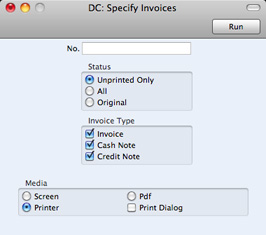
- Enter the Invoice Number for a single Invoice, or the highest and lowest Invoice Numbers of a range of Invoices separated by a colon (:). Use the Status options to specify which Invoices are to be printed:
- Unprinted Only
- This option ignores any Invoices in the range that have already been printed.
- All
- Prints all Invoices in the range. If you are not using the No Test Printout option, any previously printed approved Invoices will have the word "Copy" printed diagonally across the page as a watermark, while any unapproved Invoices will be printed with a "Test Printout" watermark.
- Original
- This option also prints all Invoices in range. Previously printed approved Invoices will be printed again as though they were original copies, without the "Copy" watermark. Unapproved Invoices will carry the "Test Printout" watermark.
Use the Invoice Type check boxes to limit your selection to specific kinds of Invoice, as described in step 6 below.
- Press the [Run] button in the Button Bar to start the printing, or cancel by closing the window.
You can also print a single Invoice by opening it in a record window and clicking the Printer icon. If you want to print to screen, click the Preview icon.
If you specified in the Invoice Form that several copies are to be printed, perhaps on different printers, these copies will only be printed the first time you print an Invoice after approving it. If you print the Invoice again, or print it before you have approved it, only one copy will be printed. If you need to print all copies again, you must print the Invoice starting from the [Documents] button, and you should choose the Original option.
Whichever method you use to print an Invoice, the Form (i.e. the stationery) used will be determined as follows:
- Using the Form register, design the invoice Form. Use the 'Properties' function on the Operations menu to name the Form (in this description, we have used the name "INVOICE") and to assign it a Document Type of "Invoice". A sample Invoice Form is supplied with Standard Invoicing: you can modify this to suit your requirements.
- Click the [Documents] button in the Master Control panel or use the ⌘-D keyboard shortcut. The 'Documents' list window is opened: highlight 'Invoices'.
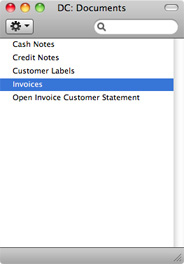
- Select 'Define Document' from the Operations drop-down menu.
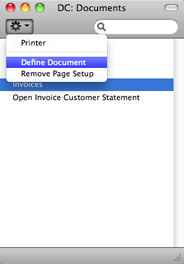
- In the subsequent window, enter "INVOICE" in the Form field of the first row (you can use 'Paste Special' to ensure the spelling is correct).
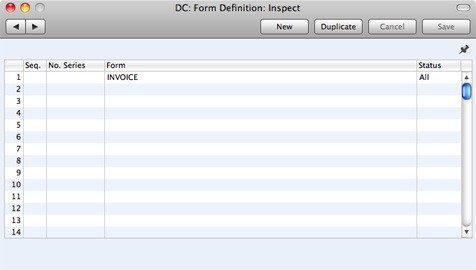
If you only want to be able to print Invoices that have been approved, enter "OKed" in the Status field. This will prevent the printing of Invoices that have not yet been approved.
You can also use this feature to use a different Form when printing unapproved Invoices, as shown below:

Use the Seq. column if you want to print more than one document from each Invoice (for example, a Delivery Note and an Invoice). The Seq. column determines the order in which the Forms will be printed. If, for example, you need the Delivery Note to be printed first, on the first line enter "1" as the Sequence Number and and choose the Delivery Note Form using 'Paste Special'. On the second line, enter "2" as the Sequence Number and specify the Invoice:
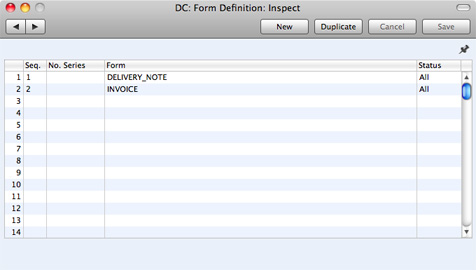
- Click [Save] to save the Invoice Form definition. From now on, the invoice form that you have designed will be used from the 'Documents' function and from the Printer icon, except as described in step 6 below.
- Repeat the previous five steps in turn for the Cash Note and Credit Note documents. These will be used from the 'Documents' function and the Printer and Preview icons instead of the standard Invoice document in the following circumstances:
- Cash Note
- If the Invoice has Payment Terms of the "Cash" type, the Cash Note document will always be used instead of the Invoice document.
- Credit Note
- If the Invoice has Payment Terms of the "Credit Note" type, the Credit Note document will always be used instead of the Invoice document.
In each of the two cases described above, if the document does not have an associated Form (steps 2-5 above), Standard Invoicing will give the warning "Can't find document" when you try to print an Invoice. If you get this warning, check the type of the Invoice before looking to see which document is missing its Form.
---
In this chapter:
Go back to home pages for:
